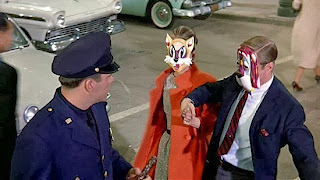Breakfast at Tiffany's (1961), Blake Edwards
3.5/5
A great romantic classic with the beautiful Audrey Hepburn as Holly Golightly the shallow manic pixie dream girl who befriends sensitive writer Paul Varjack (George Peppard). A light humorous film with great performances despite it's dated racist and sexist references.
Analysis
***Spoilers***
Holly Golightly (Audrey Hepburn) may seem to be forward for the time the film was made, but she merely represents the female stereotype of a flighty naive and promiscuous woman. It has all the classic romantic comedy scenes including the party, and the extended date sequence.
Holly dressed in a man's tuxedo shirt represents both her promiscuity and her adoption of male independence while incorporating femininity.
The film is quite provocative and suggestive in nature with numerous scenes in which Hepburn is scantily clad or undressed in towels, or night gowns. She even invites herself into bed with Paul whom she calls "Fred". Issues of identity are brought up as neither main character is referred to by their real names. Holly Golightly is revealed to be Lula Mae Barnes and she refers to Paul as Fred because he reminds her of her brother. Holly is portrayed as flirtatious and frivolous, also the dramatic and neurotic type who is bubbly one minute and then destroys her apartment when she learns of her brothers death, or gets blind drunk after her ex-husband leaves.
Holly and Fred wearing stolen masks
Also, Holly lives on the wealth of rich men, with no real furniture and possession and a cat named "cat". These three characters Holly, Fred and Cat are merely placeholders for characters in the genre. On the other hand Paul represents the typical white male stereotype of the sensitive writer, also he is somewhat ironic as he quotes a review of his writing from the New York Times "Mainly they're angry sensitive, intensely felt, and that dirties of all dirty words - promising". Here this dialogue seems to be a self-conscious reflection of the character trope of the sensitive male love interest. In the end a flirtatious wild spirited woman is transformed into the traditional good woman by conforming to male standards of marriage and role, by uniting with Paul in favour of love rather than money. This theme of identity is exemplified by the image of the two lovers wearing masks (see above). In addition this demonstrates how at the resolution both have taken off their metaphorical "masks" where Paul demands that he loves her in the library saying "My name isn't Fred it's Paul Varjack...", but it isn't until the end where Holly admits "I'm not Holly. I'm not Lula Mae, either. I don't know who I am! I'm like Cat here, a couple of no name slobs. We belong to nobody and nobody belongs to us. We don't even belong to each other."
Paul, Holly and Cat unite
This image supports this notion nicely as the trope of man, woman and child is reunited, with Cat the placeholder representing the child (which implies the inevitable of marriage and children). Disappointingly this continues the notion that wild independent women eventually conform to the will of males becoming what the patriarchy deems their role to be as wife and mother.




No comments:
Post a Comment